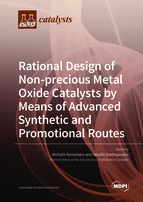Rational Design of Non-precious Metal Oxide Catalysts by Means of Advanced Synthetic and Promotional Routes
A special issue of Catalysts (ISSN 2073-4344). This special issue belongs to the section "Environmental Catalysis".
Deadline for manuscript submissions: closed (31 December 2020) | Viewed by 57336
Special Issue Editors
Interests: heterogeneous catalysis; surface science; materials science; rational design of metal oxides; nanocatalysis; promotion in catalysis; metal-support interactions; structure-property relationships
Special Issues, Collections and Topics in MDPI journals
Interests: environmental ceramics; functional coatings; surface phenomena; energy-related applications of ceramics and coatings; catalysts
Special Issues, Collections and Topics in MDPI journals
Special Issue Information
Dear Colleagues,
Catalysis is an indispensable part of our society, massively involved in numerous energy and environmental applications, such as air pollution control, petrochemical industry, fuel cells, manufacturing of commodity chemicals, production of value-added chemical fuels, among others. Noble metal (NMs)-based catalysts are routinely employed in numerous catalytic processes, but their scarcity and high cost makes them disincentive for practical applications. In view of this fact, the rational design and development of NMs-free oxides of adequate catalytic activity, selectivity and durability is currently one of the main research pillars in the area of heterogeneous catalysis. Towards this direction, however, one crucial question must be answered: Is it possible to fine-tune the local surface chemistry/structure of a single, binary or multicomponent metal oxide in order to be highly efficient-like a noble metal-in a specific process? Thanks to the huge research progress so far achieved in the fields of surface science, nanochemistry, catalyst promotion or chemical modification, the answer to the aforementioned question is certainly yes.
Nowadays the catalytic performance of transition metal oxides, such as ceria-based mixed oxides, perovskites, hexaaluminates, hydrotalcites, and spinels can be considerably enhanced by tailoring the local surface structure (e.g., work function, reducibility, oxygen vacancies) and interfacial phenomena (e.g., metal-support interactions). The latter can be accomplished via the following strategic approaches that could be applied independently or in synergy: (i) employment of state-of-the art nano-synthesis routes towards engineering particle’s size and shape (e.g., nanocubes, nanorods), ii) use of structural/surface promoters (e.g., alkali, graphene oxide) towards the optimization of structural and electronic properties, iii) employment of special pretreatment protocols towards the regulation of surface chemistry and metal-support interactions. This holistic approach in conjunction to the fundamental understanding of metal-support interactions (either geometric or electronic) is expected to lead to the development of low cost (NMs-free), highly active and stable catalysts, for real life applications in the energy and environmental sector.
In light of the above aspects, the present Special Issue is mainly focused on the recent fundamental and experimental advances in relation to the rational design and fine-tuning of NMs free metal oxide catalysts. Advanced synthetic and promotional/modification routes towards the development of highly active composites for energy (e.g., WGS, PROX, CO2 hydrogenation) or environmental (e.g. NOx, N2O, VOCs emissions control) applications are perfectly matched to this themed issue. Moreover, in-depth characterizations studies by means of advanced characterization techniques (both ex situ and in situ) and computational calculations (e.g., DFT method) towards unraveling the fundamental origin of the synergistic metal-support interactions and the establishment of rigorous structure-property relationships are very welcome.
Dr. Michalis Konsolakis
Dr. Vassilis Stathopoulos
Guest Editors
Manuscript Submission Information
Manuscripts should be submitted online at www.mdpi.com by registering and logging in to this website. Once you are registered, click here to go to the submission form. Manuscripts can be submitted until the deadline. All submissions that pass pre-check are peer-reviewed. Accepted papers will be published continuously in the journal (as soon as accepted) and will be listed together on the special issue website. Research articles, review articles as well as short communications are invited. For planned papers, a title and short abstract (about 100 words) can be sent to the Editorial Office for announcement on this website.
Submitted manuscripts should not have been published previously, nor be under consideration for publication elsewhere (except conference proceedings papers). All manuscripts are thoroughly refereed through a single-blind peer-review process. A guide for authors and other relevant information for submission of manuscripts is available on the Instructions for Authors page. Catalysts is an international peer-reviewed open access monthly journal published by MDPI.
Please visit the Instructions for Authors page before submitting a manuscript. The Article Processing Charge (APC) for publication in this open access journal is 2700 CHF (Swiss Francs). Submitted papers should be well formatted and use good English. Authors may use MDPI's English editing service prior to publication or during author revisions.
Keywords
- Heterogeneous catalysis
- Energy and environmental applications
- Rational design of NMs-free metal oxides
- Ceria-based oxides; perovskites; hexaaluminates; hydrotalcites; spinels, etc.
- Novel synthetic techniques
- Shape and size effects in catalysis
- Surface/structure promotion
- Advanced characterization studies
- Tailoring surface reactivity
- Fine-tuning of metal-support interactions







